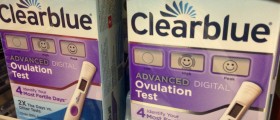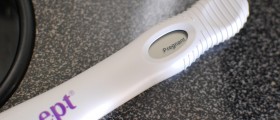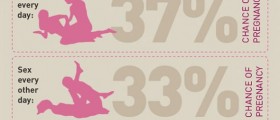
The user (and although it should be obvious, the user is always the female partner) places the test strip in her urine stream for three seconds and then inserts the test strip into a monitor. The ClearBlue Easy Fertility Monitor Kit is designed to measure changes in estrogen and luteinizing hormone. Because the kit measures changes, it is important to start testing before the user is likely to be at her monthly peak fertility. Estrogen levels peak a day or two before the egg is released during ovulation. Luteinizing hormones peak the day of ovulation. Since a woman is at her greatest fertility the day or perhaps two days after ovulation, the monitor kit shows "highest fertility" just after estrogen levels have peaked and luteinizing hormone is still peaking. If the kit is not used before ovulation, however, it cannot precisely measure the day of ovulation. If all women had perfectly regular cycles, the ClearBlue Easy Fertility Kit would not be necessary.
In women who have precisely 28-day cycles, the best time to have intercourse is on days 11 through 16. The male partner is advised to abstain from intercourse and masturbation to maximize his sperm count to coincide with maximum fertility. But if the woman's period is not precisely 28 days long--and in many women it isn't--then the best days for intercourse may not be the eleventh through sixteenth days after she has menstrual bleeding.
The ClearBlue system requires women to use 10 test strips every month, starting on the tenth day of the woman's period. This allows the monitor to detect the hormonal changes around ovulation even if the woman's period is as short as 21 days or as long as 42 days. There is just one factor the system can't account for. In a few women, ovulation is a day or two later than hormone levels would predict. Even if the system is used perfectly - and it won't work if the urine sample is not taken with the very first urination of the day - these couples may be more likely to get pregnant if they have intercourse on the seventeenth day of the woman's period, or the eighteenth. If low sperm counts or sperm motility are also an issue, these couples may want to delay intercourse to the very last fertile day to ensure greatest opportunities to conceive.
- www.nhs.uk/news/pregnancy-and-child/hormonal-fertility-tests-waste-time-and-money/
- medlineplus.gov/spanish/ency/article/007062.htm
- Photo courtesy of SPD Swiss Precision Diagnostics GmbH by Wikimedia Commons: commons.wikimedia.org/wiki/File:Clearblue_logo.jpg















Your thoughts on this
Loading...